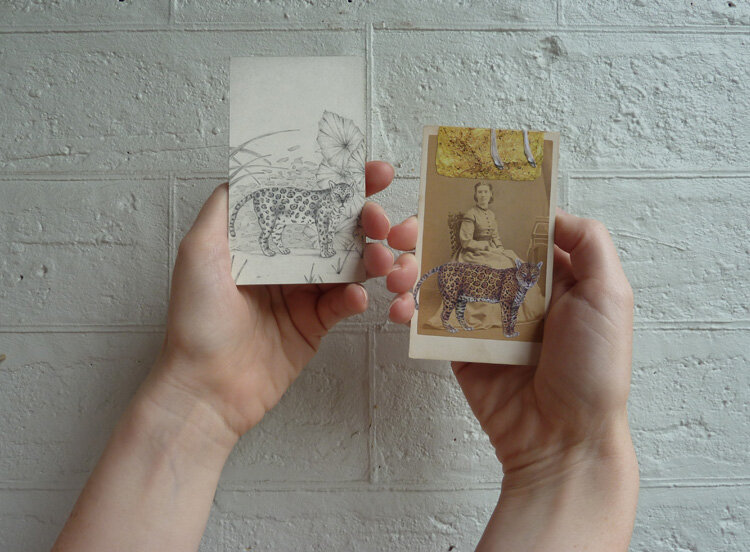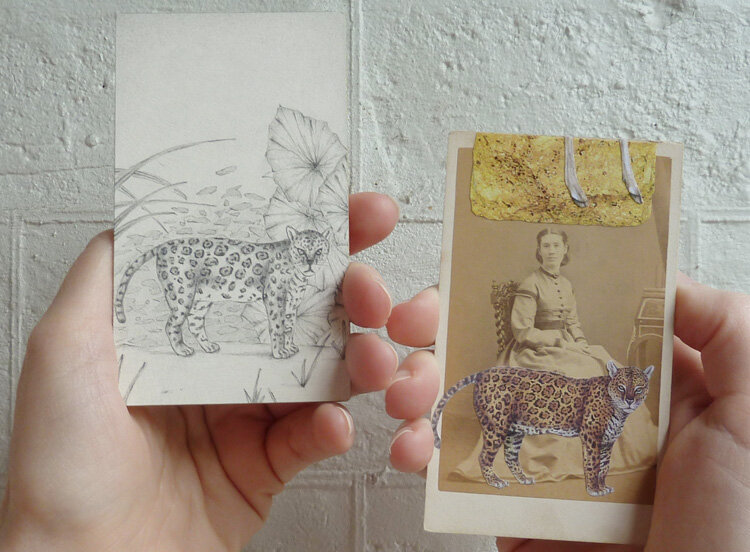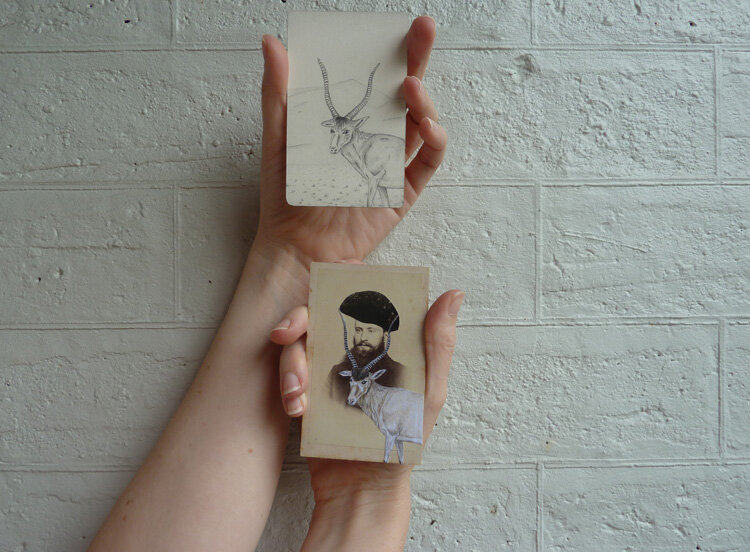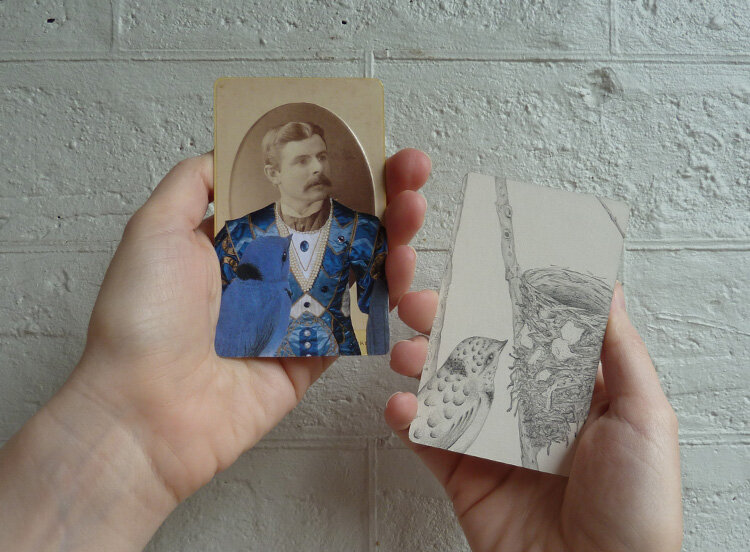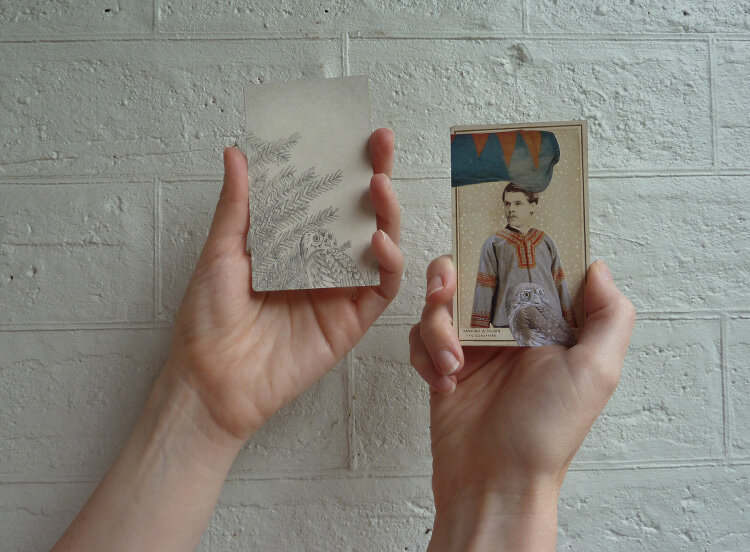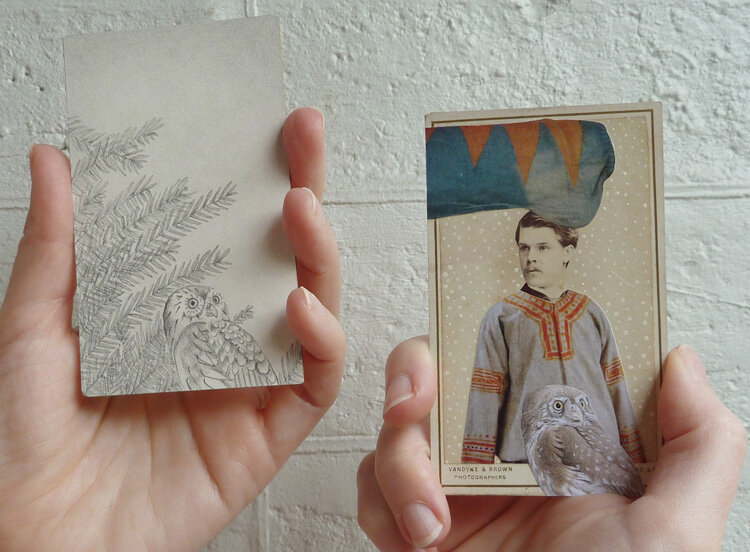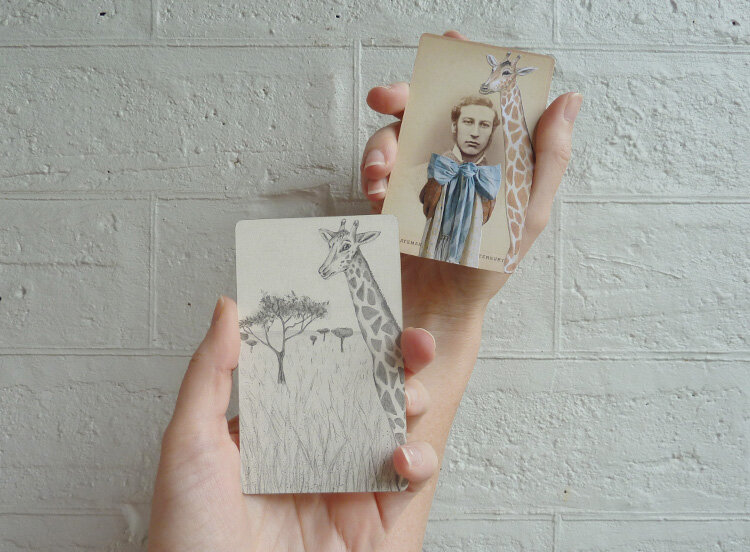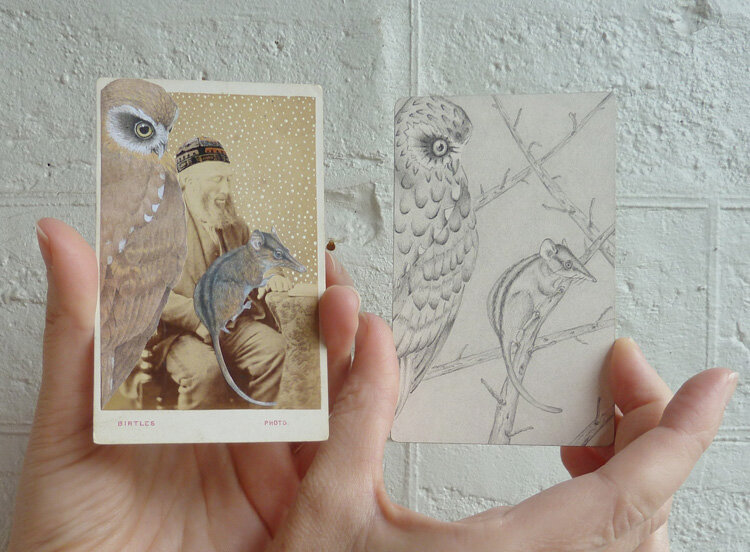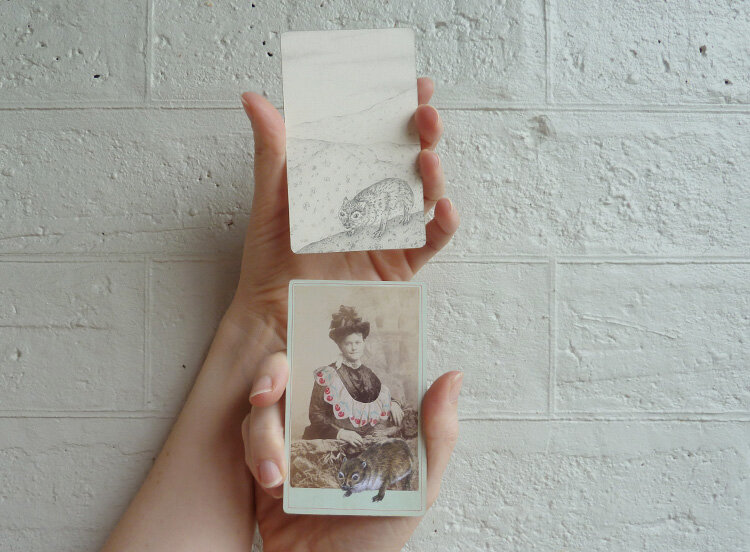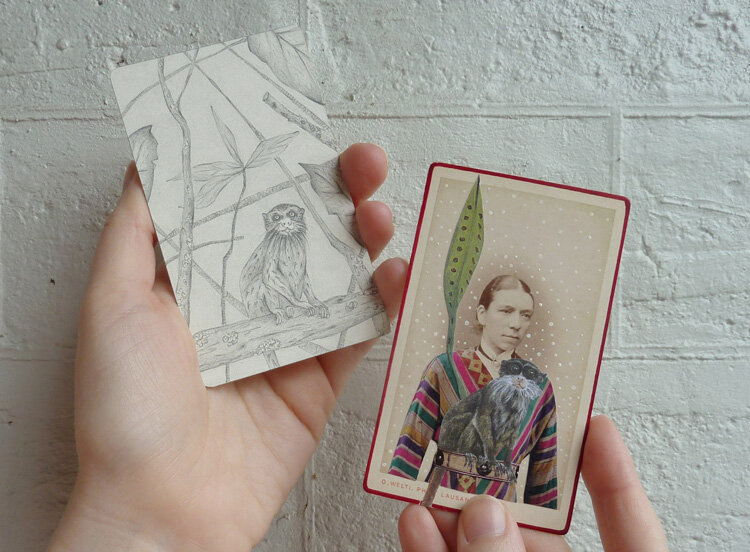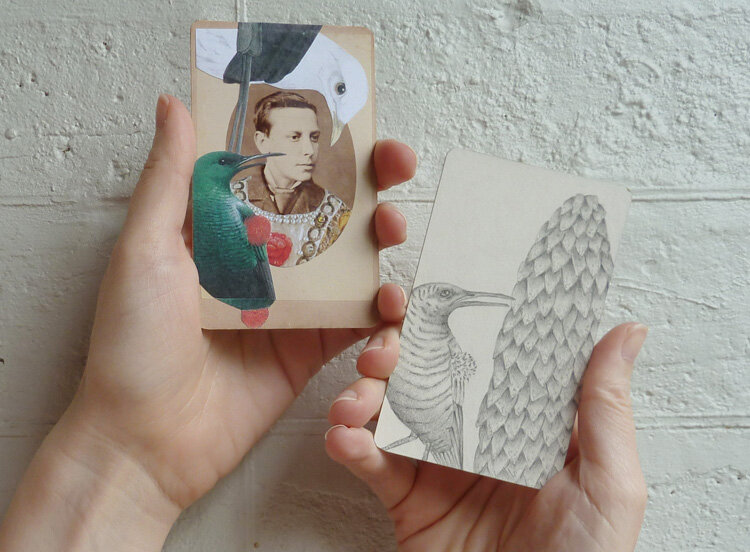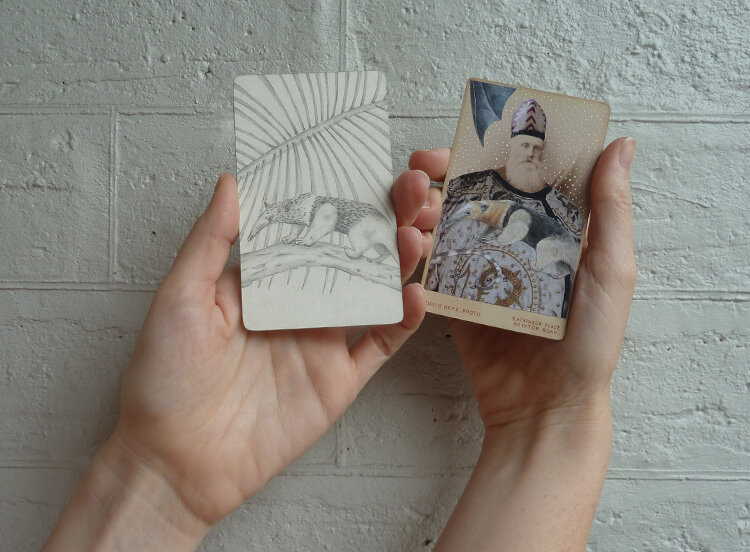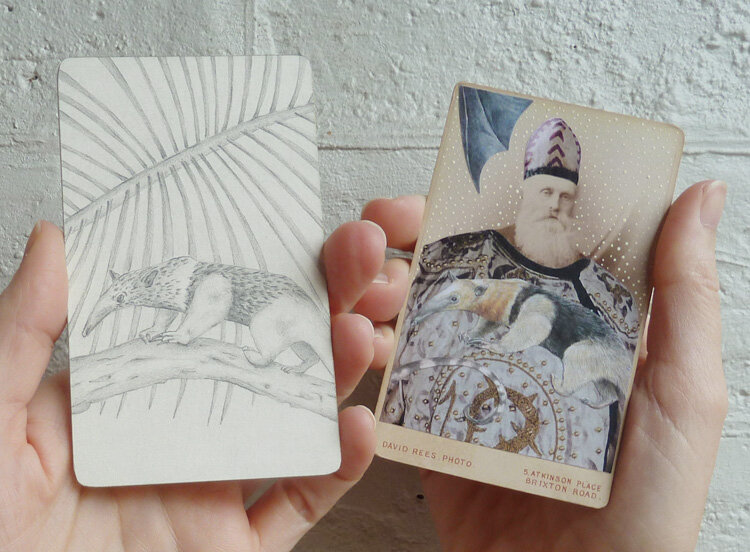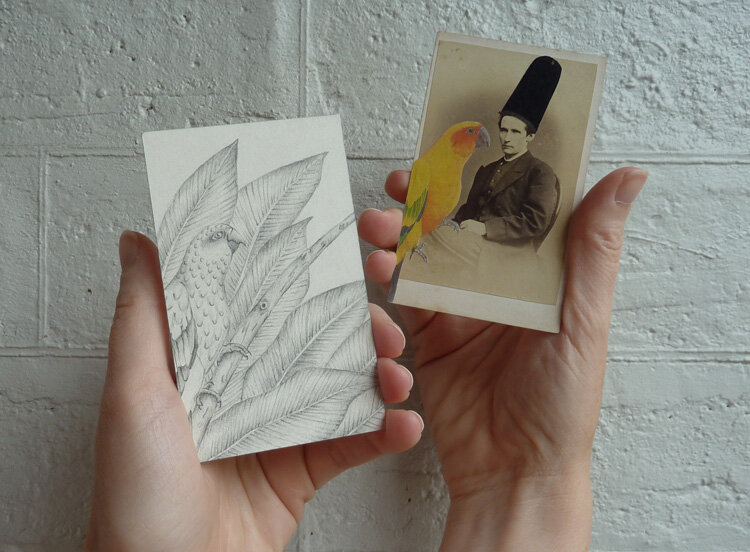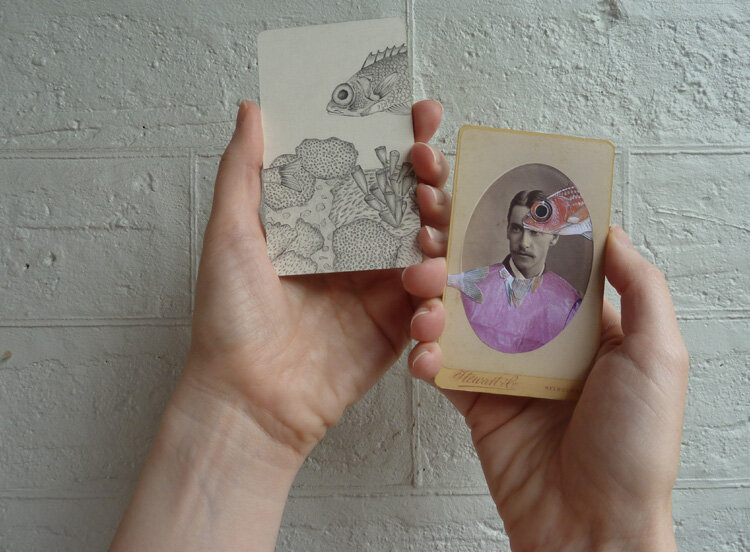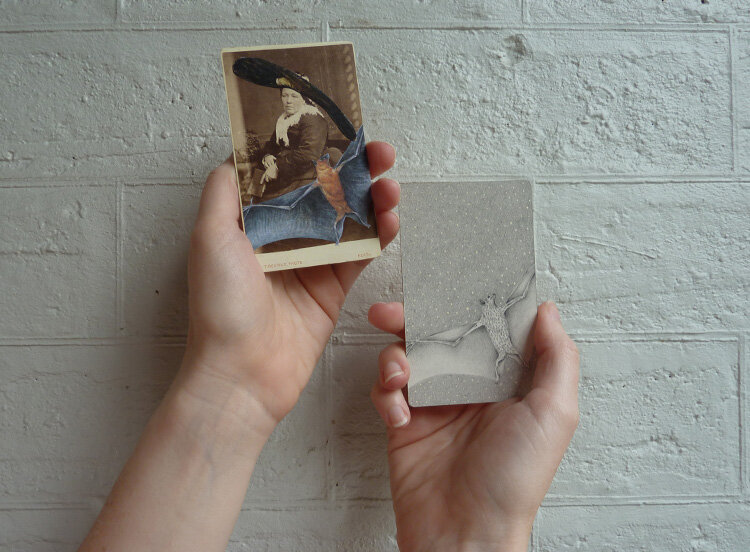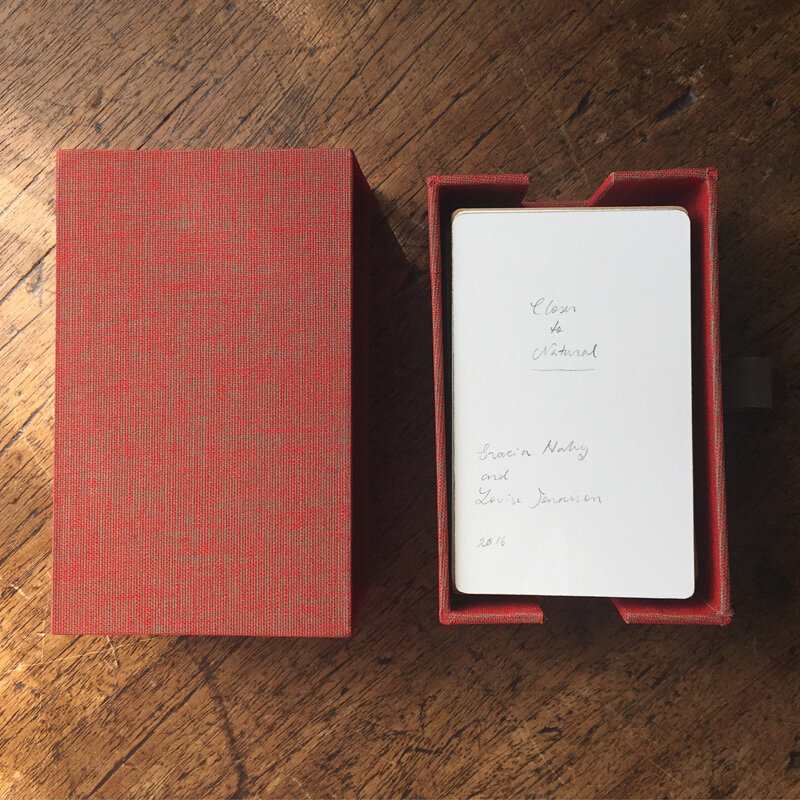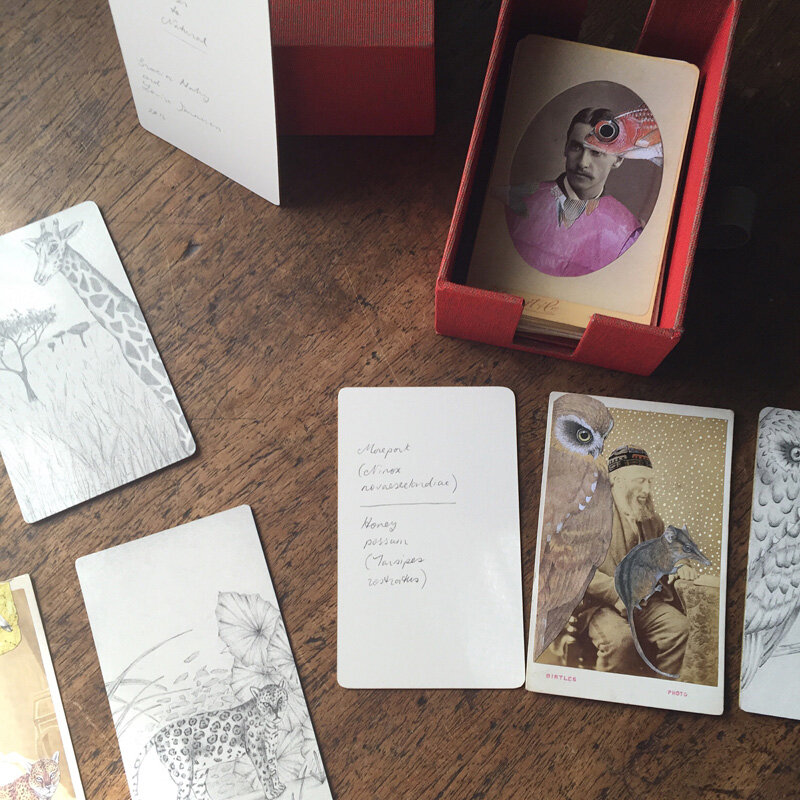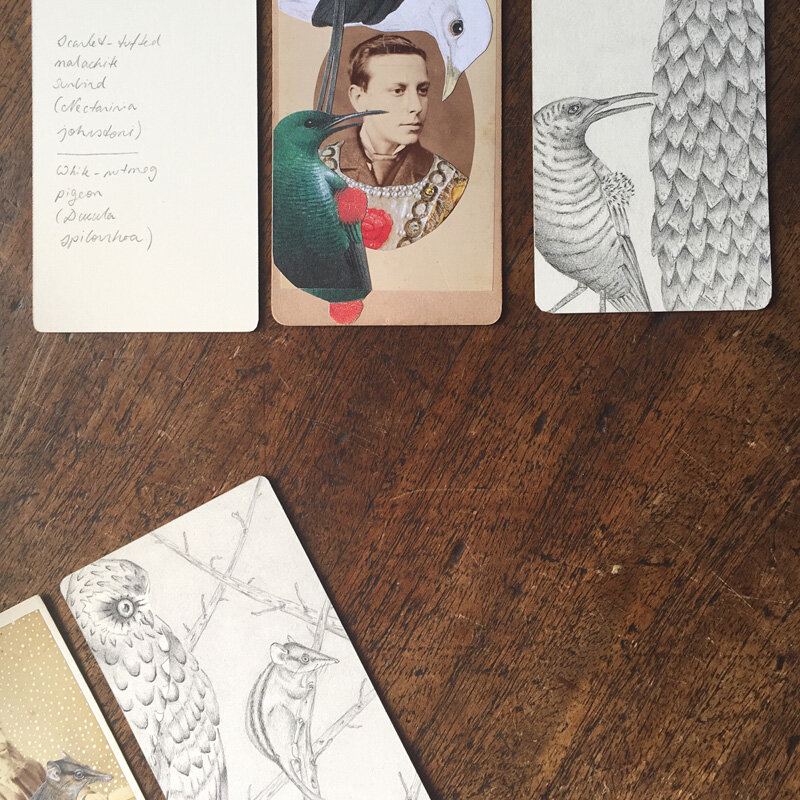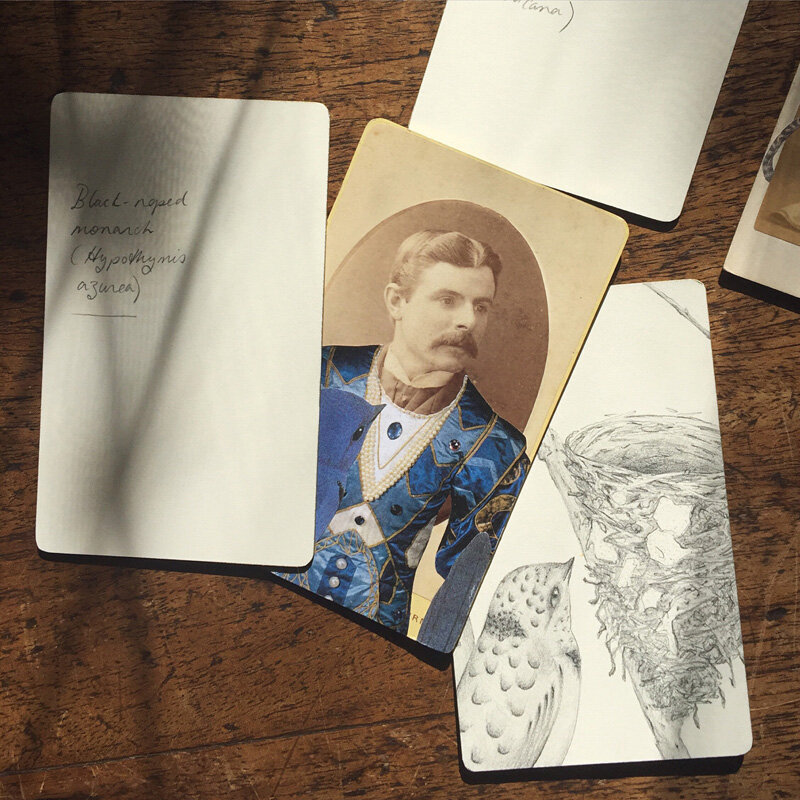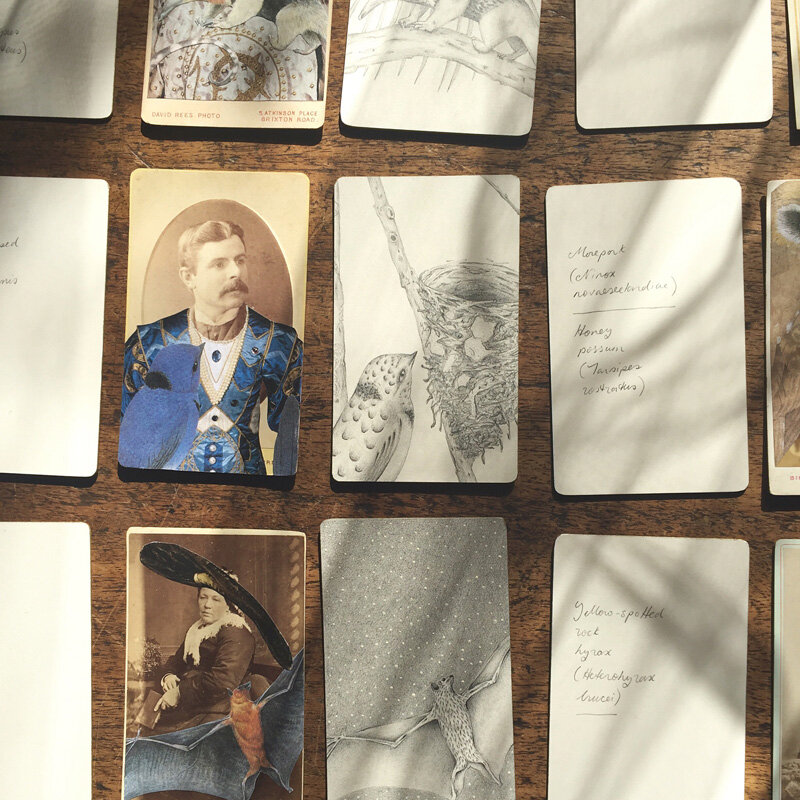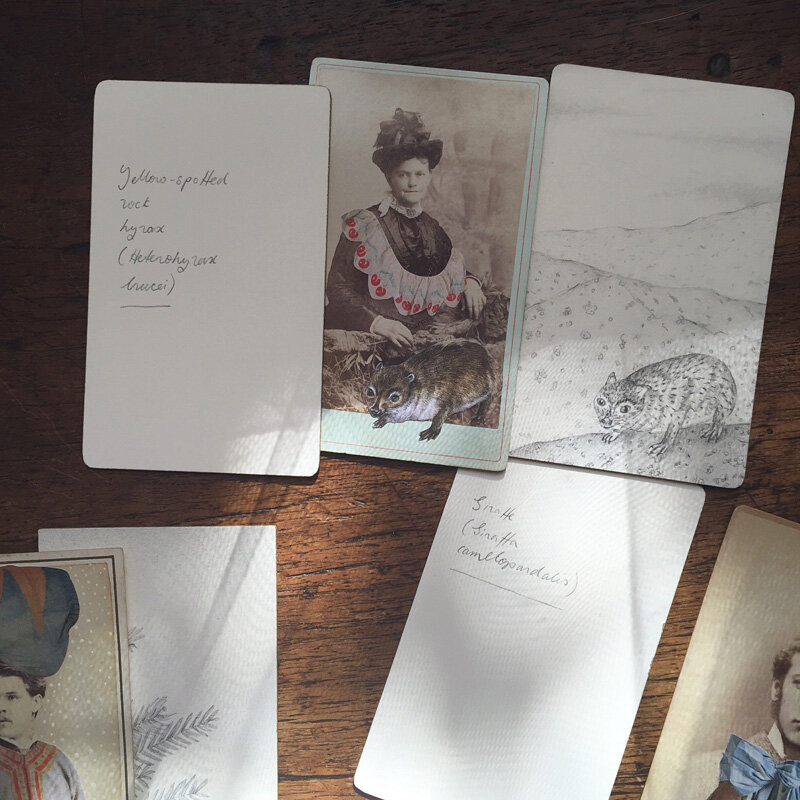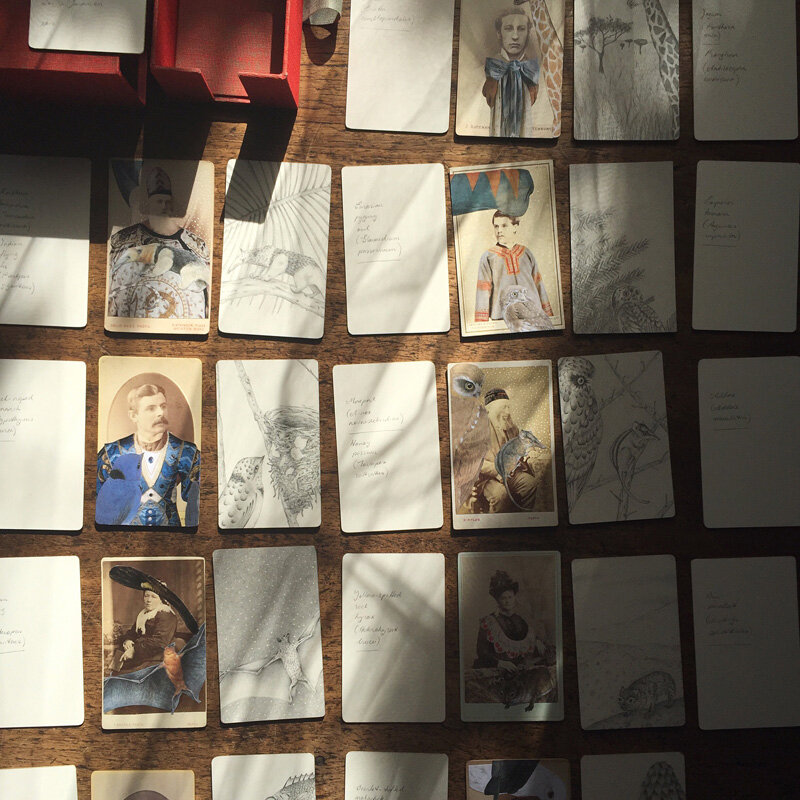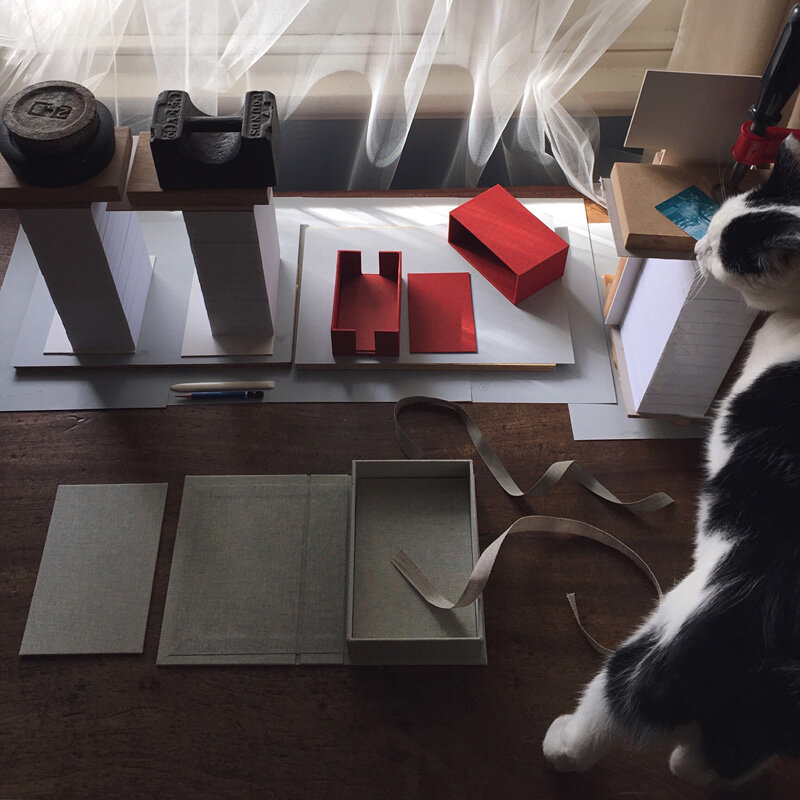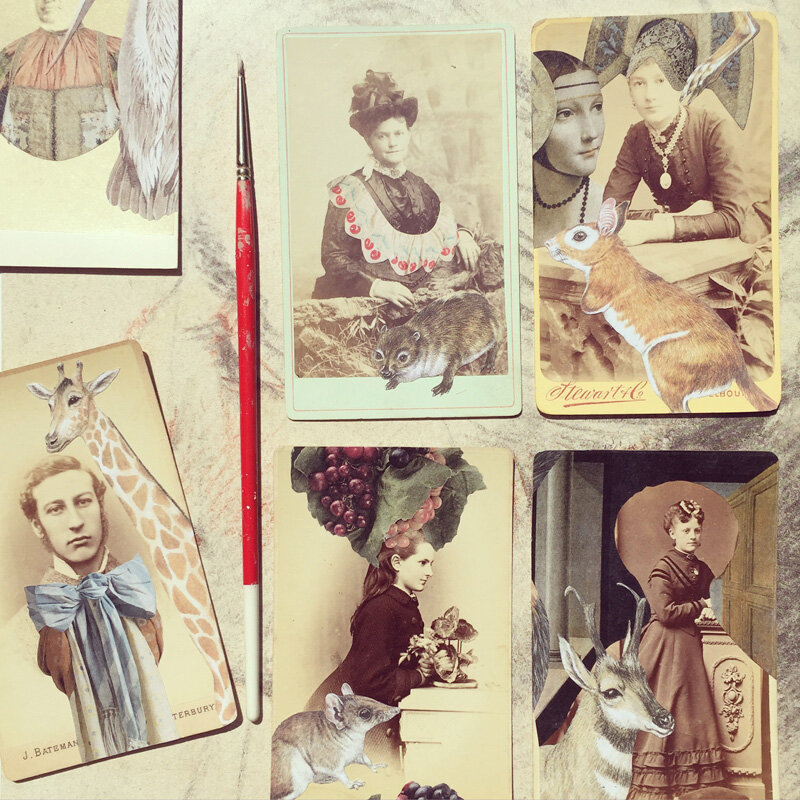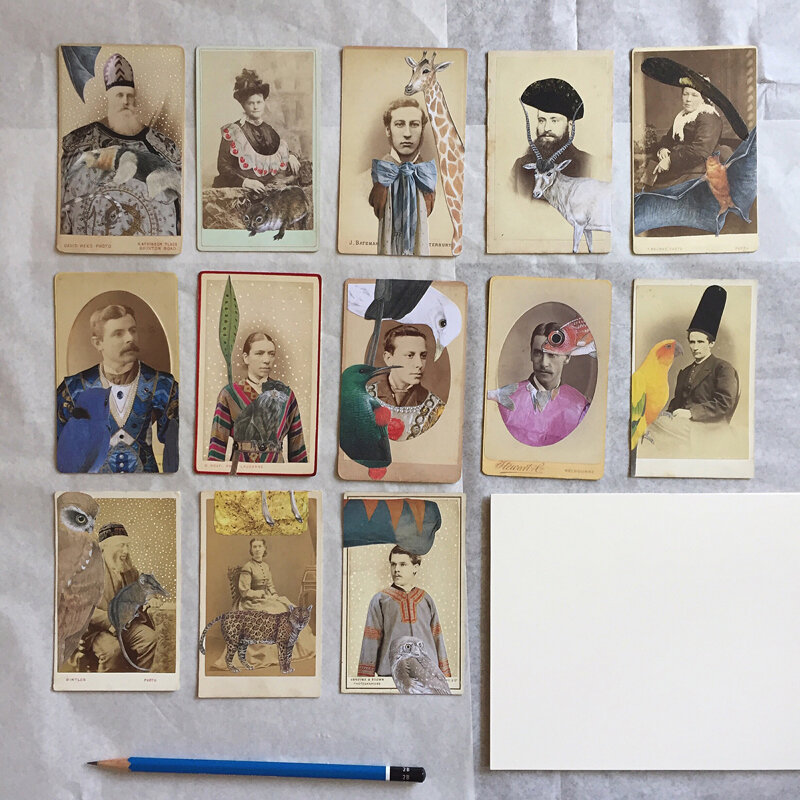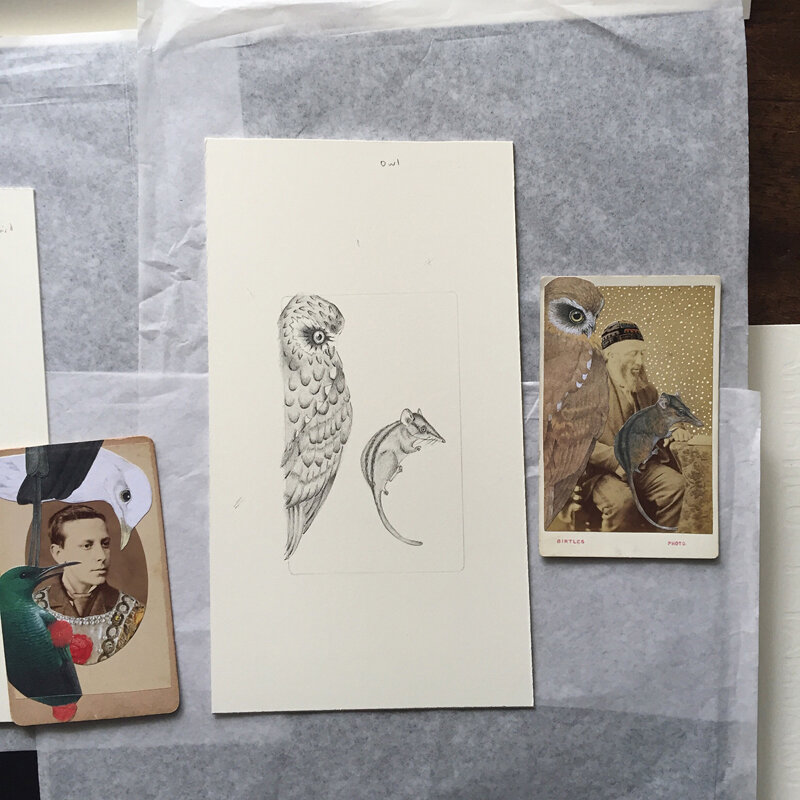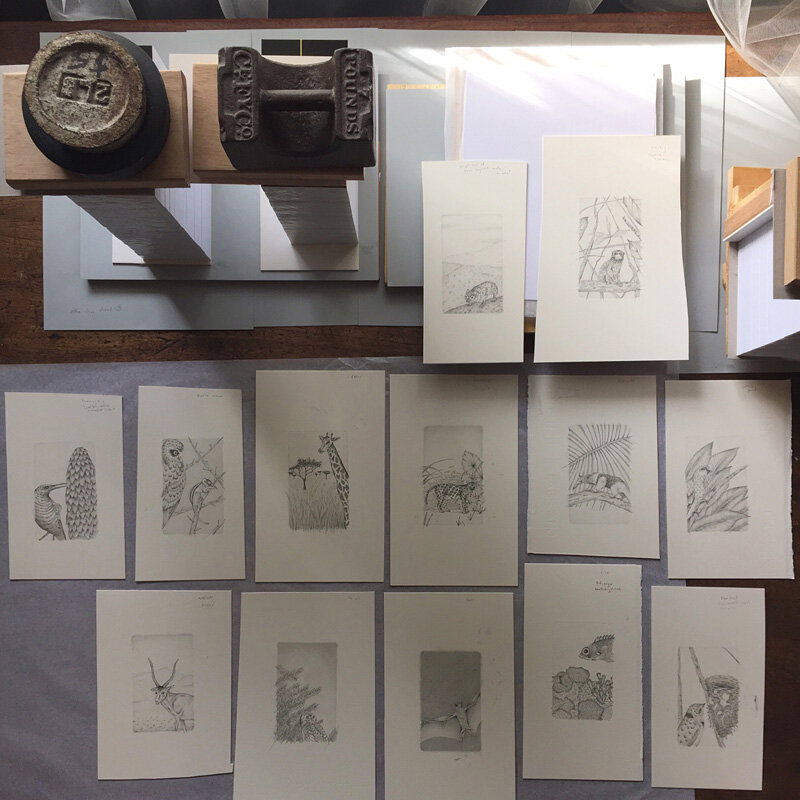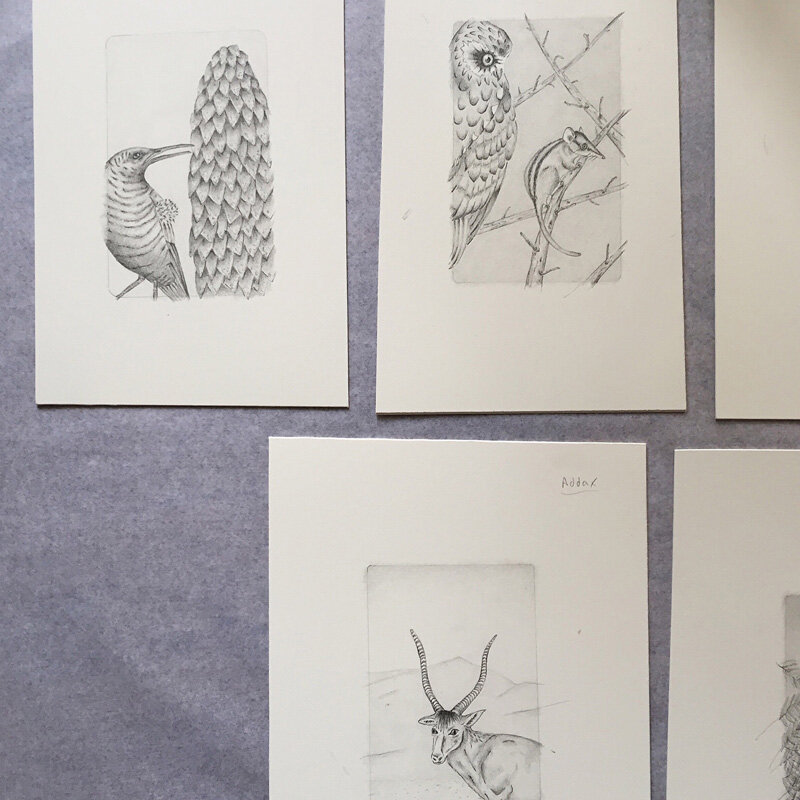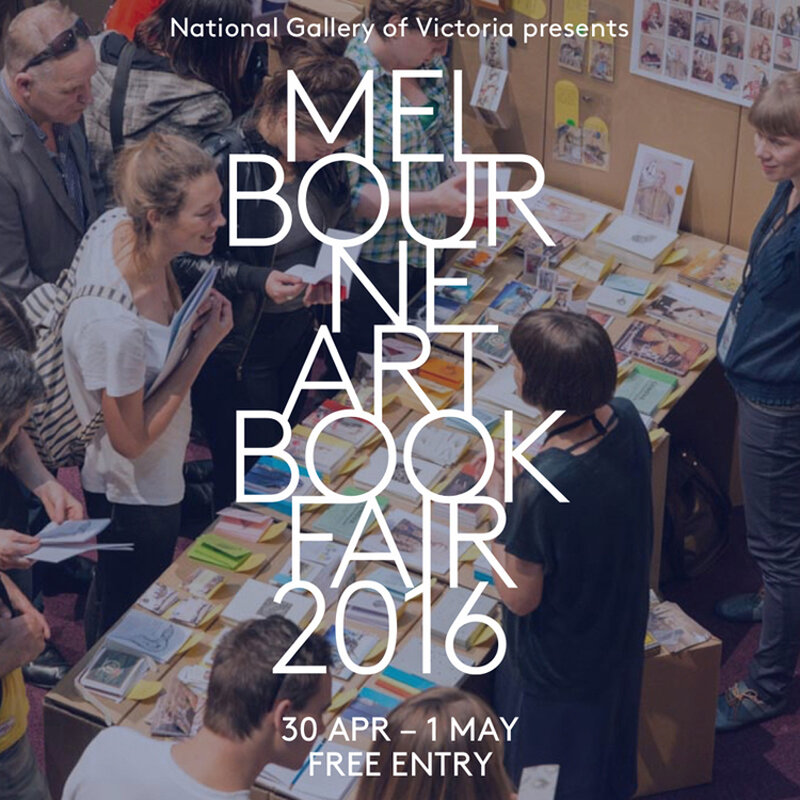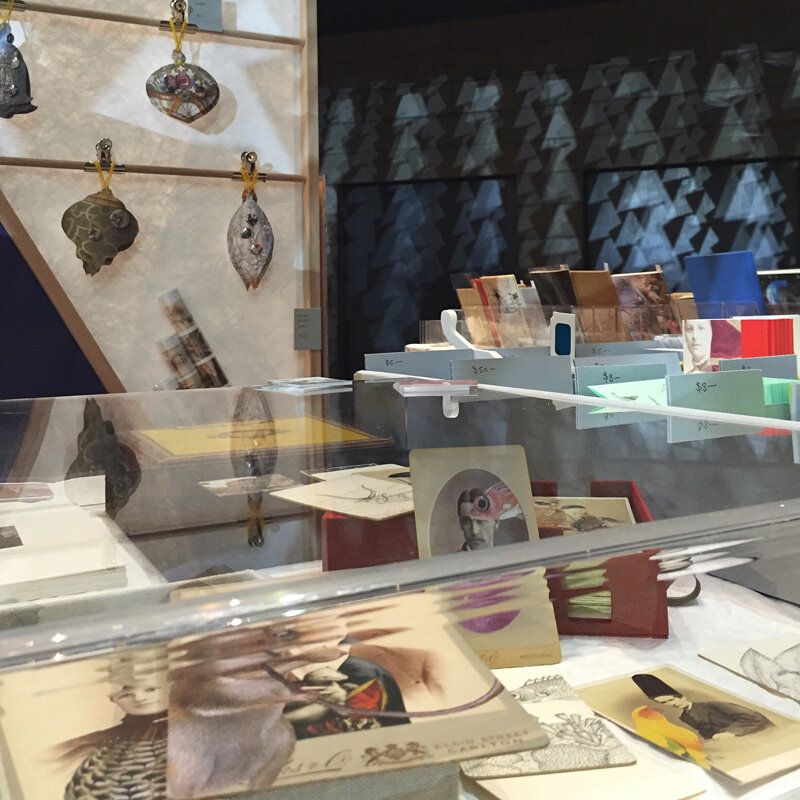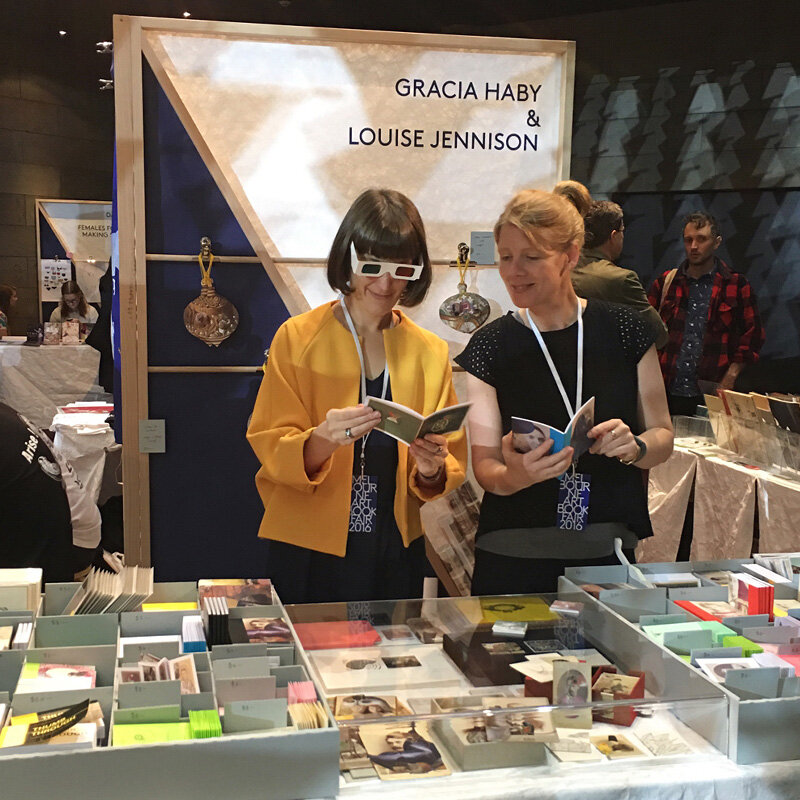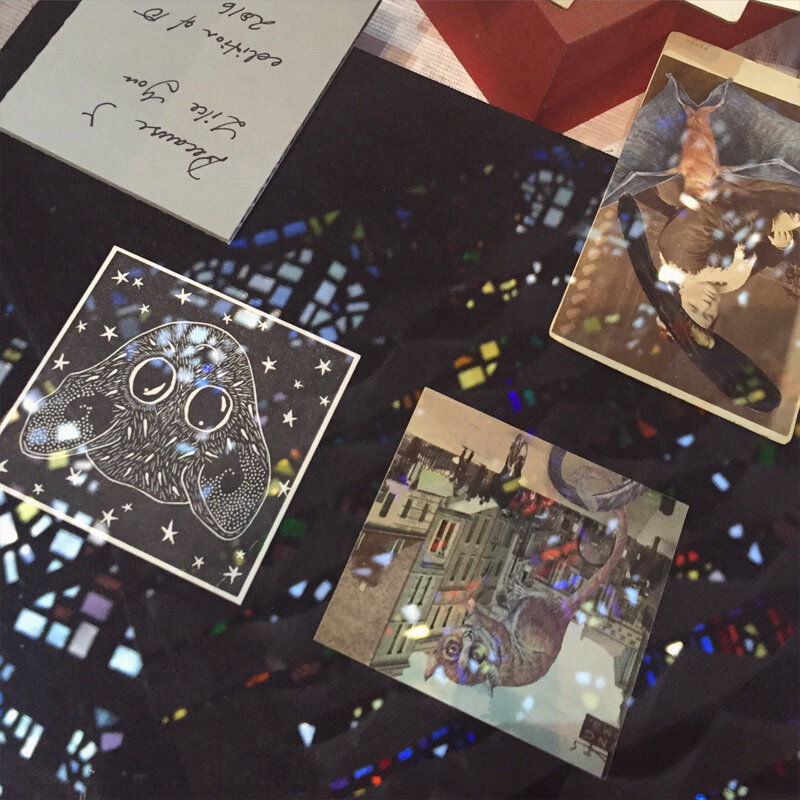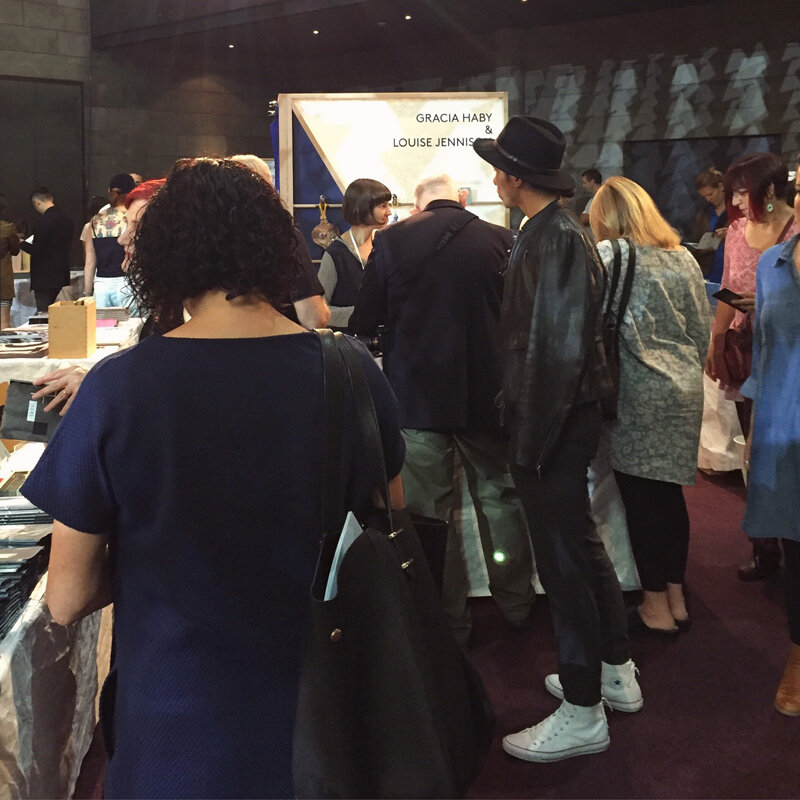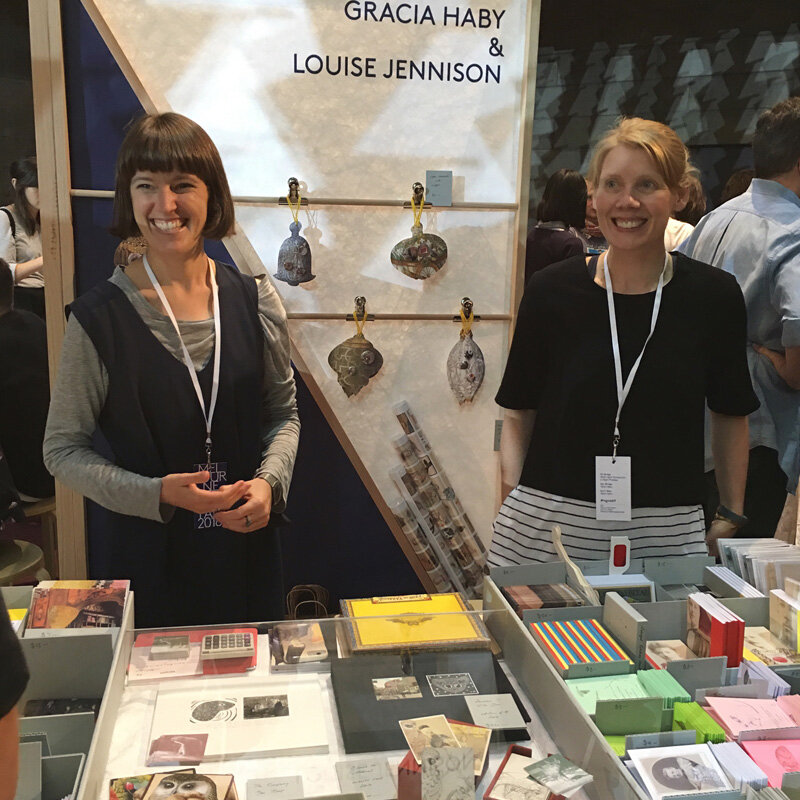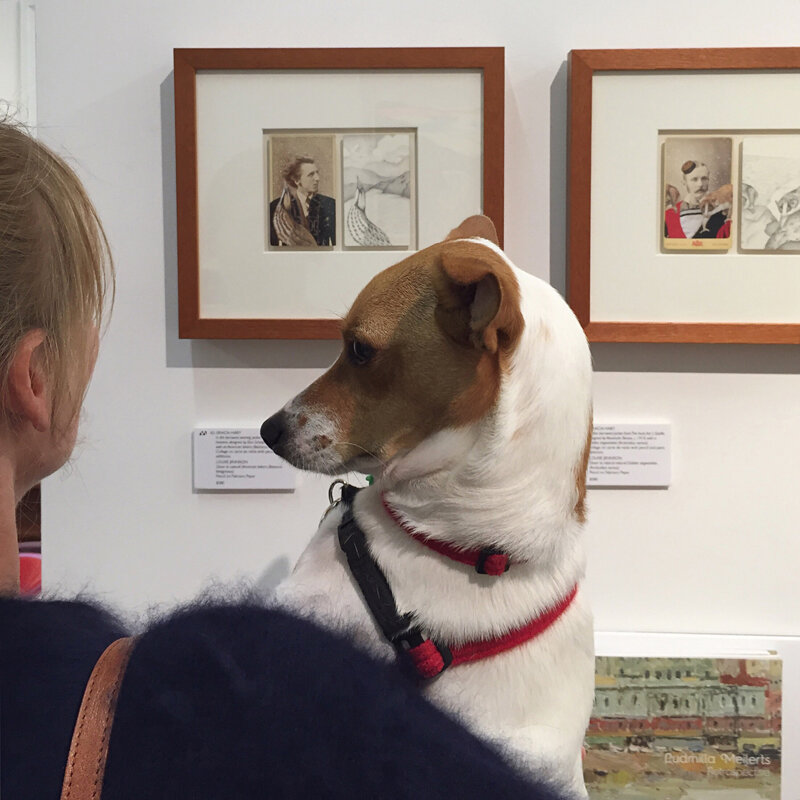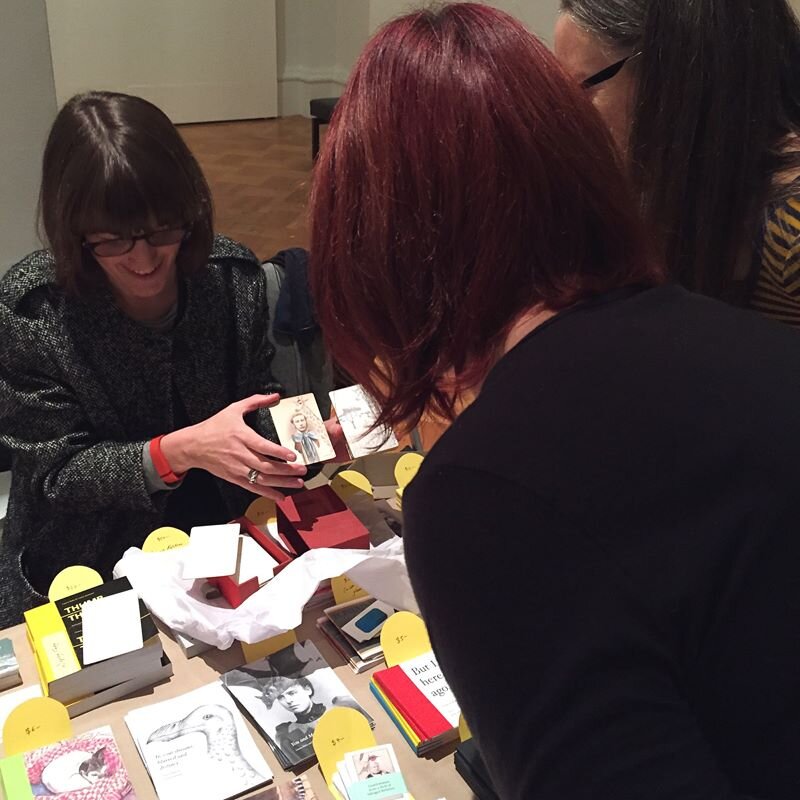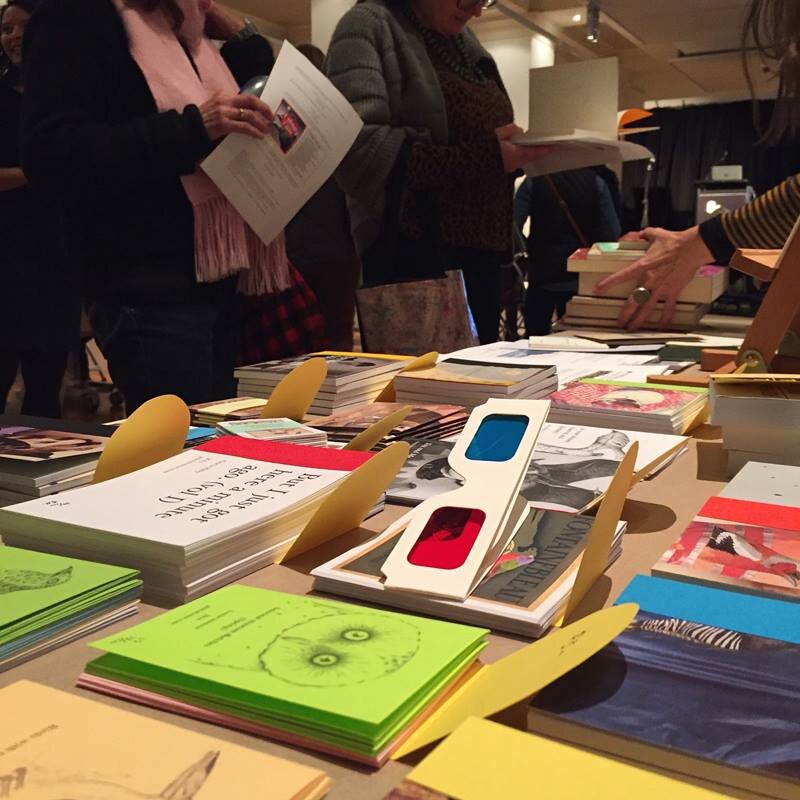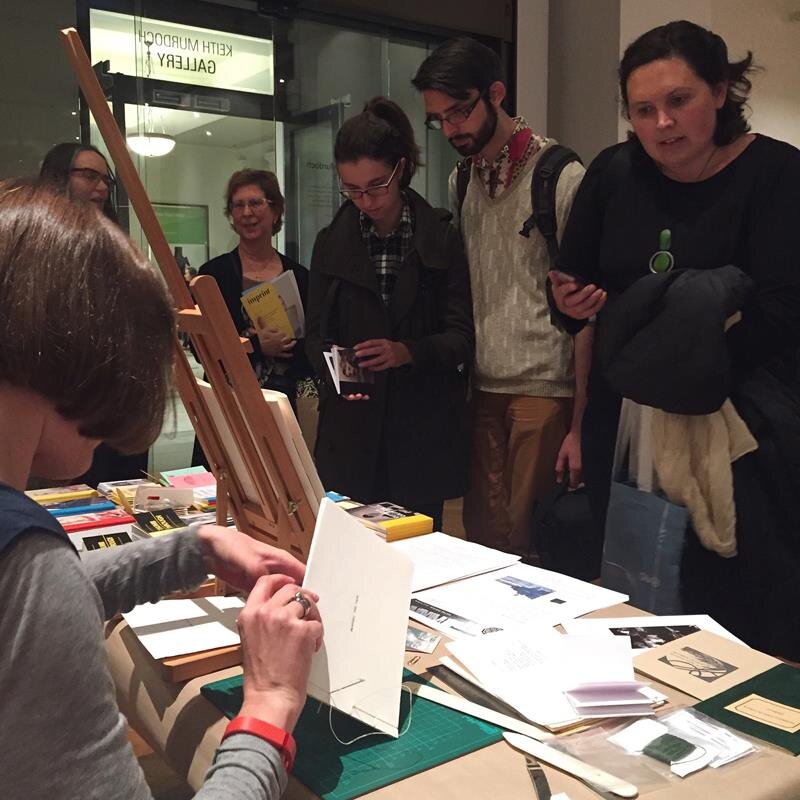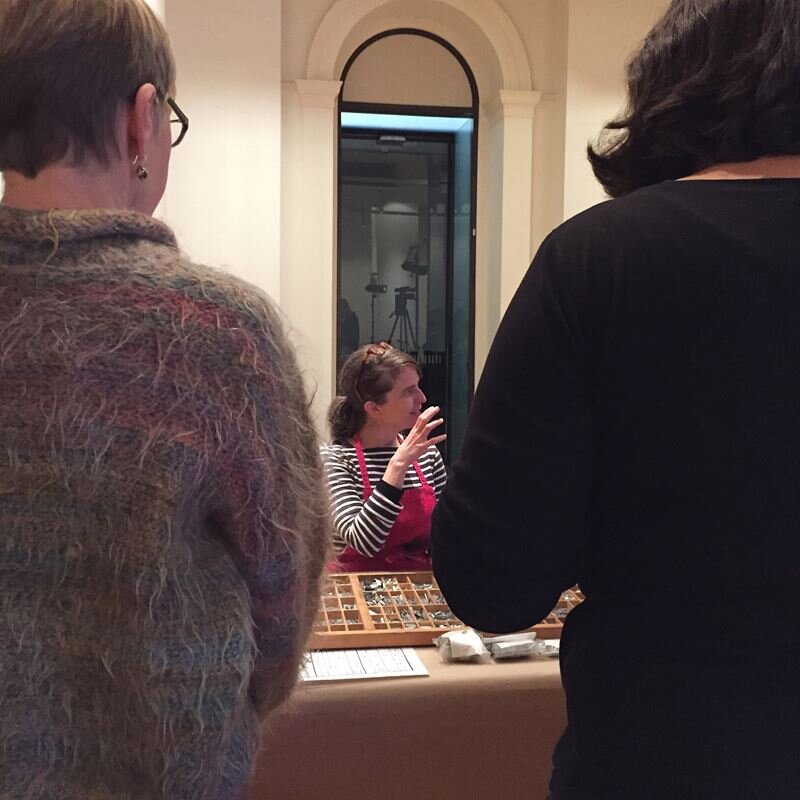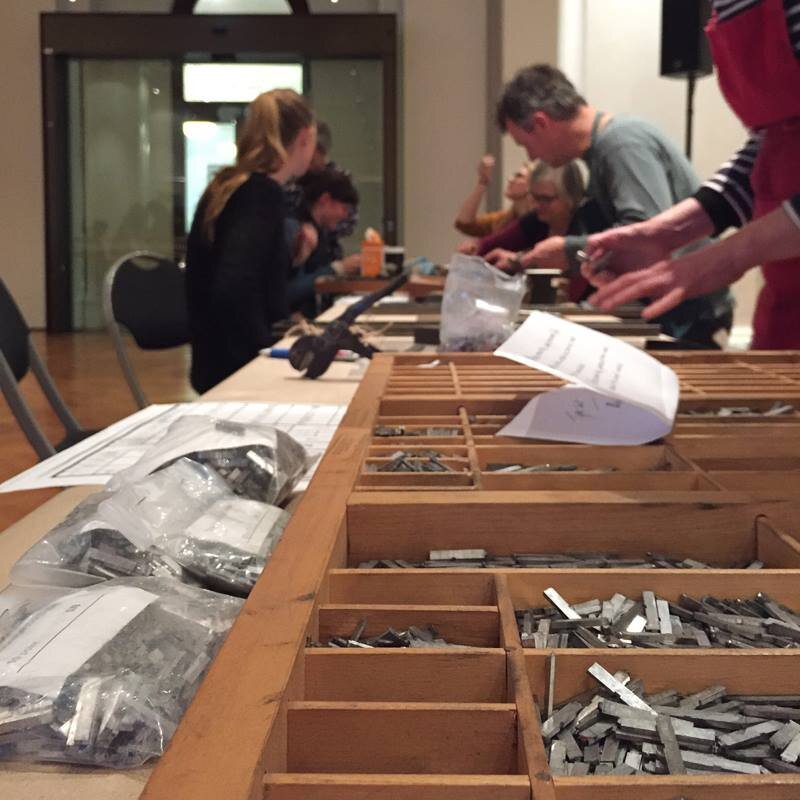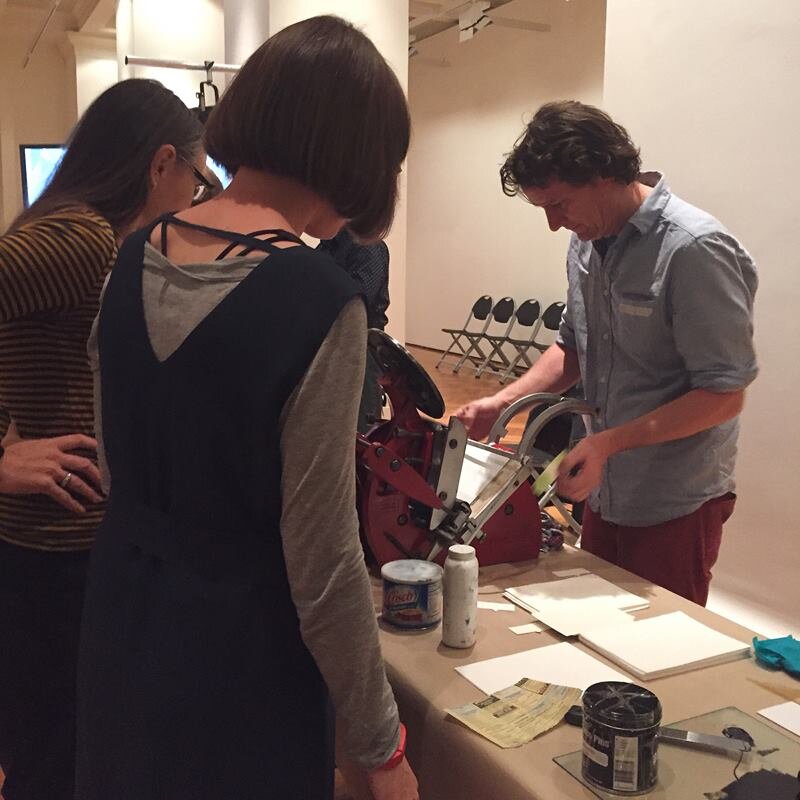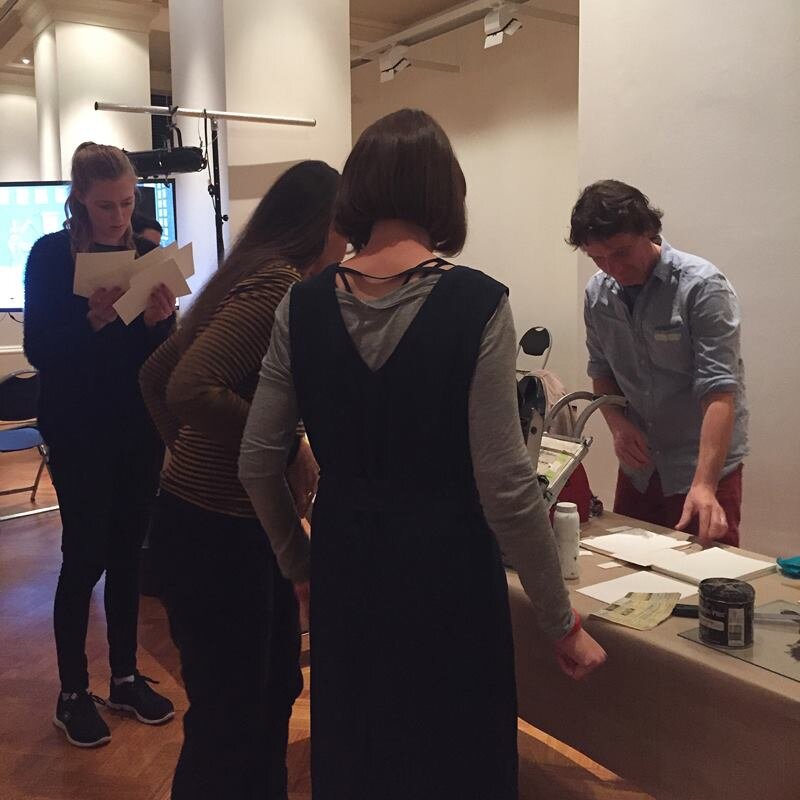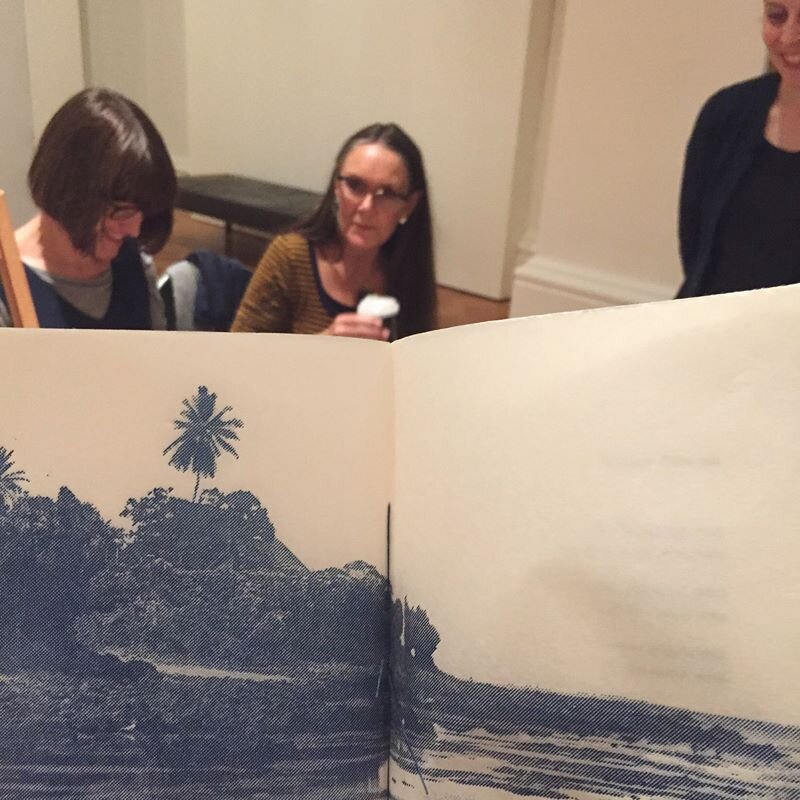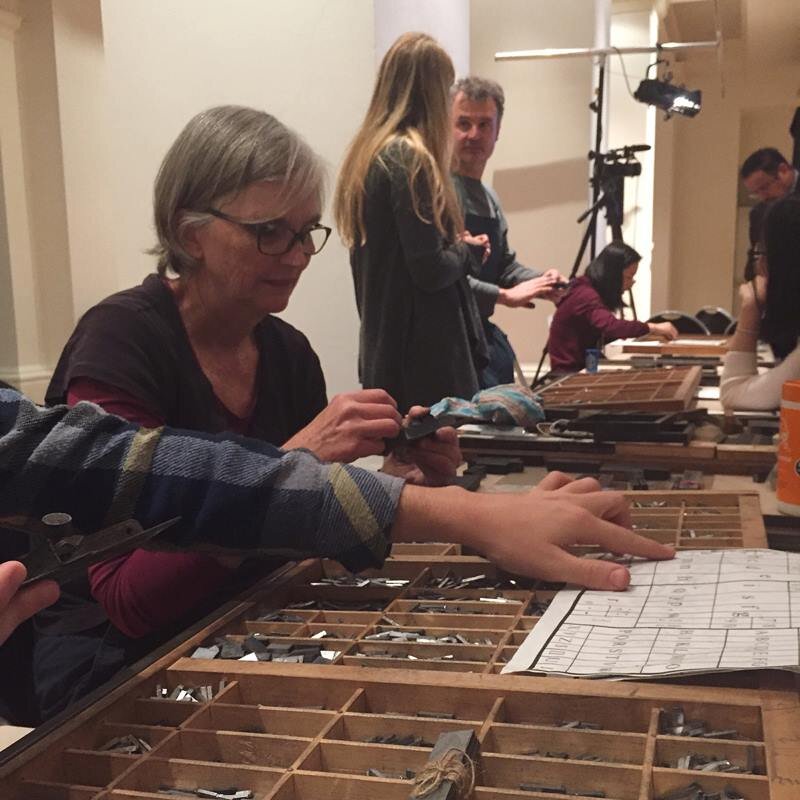CLOSER TO NATURAL
Call and response, collage and drawing.
Gracia Haby & Louise Jennison
Closer to Natural
2016
Artists’ book, unique state, featuring 13 individual collages on cartes de visite with pencil and paint additions (by Gracia Haby), 13 pencil drawings on Fabriano Artistico 640gsm traditional white hot-press paper with metallic paint trim (by Louise Jennison), and accompanying handwritten animal title cards
Housed in a red cloth Solander box (bound by Louise Jennison)
In continuation of a theme explored for Animal Instinct (2016), thirteen costumed Salvaged Relatives on cartes de visite have been paired with drawings of the same collage element in a new and arguably more natural setting. However, upon closer inspection, the landscape reveals itself to be that of a theatrical backcloth. The stained costumes of the Ballet Russes, designed by Léon Bakst and after Henri Matisse, feature alongside Scarlet-tufted malachite sunbirds (Nectarinia johnstoni) and Bearded emperor tamarins (Saguinus imperator subgrisescens) in this jewel-boxed, call and response, collage and drawing, past and present collection.
This artists’ book was released into the wild at the 2016 Melbourne Art Book Fair at the National Gallery of Victoria.
It was exhibited as part of the 2016 Libris Awards and was acquired by Artspace Mackay.
Closer to Natural has since been exhibited as part of Focus on the Collection: Gracia Haby & Louise Jennison in the Foyer Gallery of Artspace Mackay (Friday 30th of November, 2018 – Sunday 3rd of February, 2019). The exhibition, drawn from the Mackay Regional Council collection, also included our artists’ books Find your place (2007); Small collection (2008); Postcards from... a key to make your own world visible (2009); A vagary of impediments & a sneak of weasels (2009); Tumble & fall (2009); This evening, however, I am thinking of things past (2009); Prattle, scoop, trembling: a flutter of Australian birds (2016); and Paw Pad Path (2018).
●
1. In the borrowed costume for a Syrian woman from Cléopâtre for a necktie, designed by Léon Bakst, c 1909–30s, with a giraffe (Giraffa camelopardalis)
and
Closer to natural (Giraffe (Giraffa camelopardalis))
2. In the garb of the understudy, with a Jaguar (Panthera onca) and a Pronghorn (Antilocapra americana)
and
Closer to natural (Jaguar (Panthera onca) and Pronghorn (Antilocapra americana))
3. After Henri Matisse, in the borrowed costume for a Courtier from The song of the nightingale, 1920, with gold studs, paint, satin, and braid, with a Northern tamandua (Tamandua mexicana) and an Indian flying fox (Pteropus giganteus)
and
Closer to natural (Northern tamandua (Tamandua mexicana) and Indian flying fox (Pteropus giganteus))
4. In the stained costume of an Elder from The Rite of Spring, circa 1913, with a Eurasian pygmy owl (Glaucidium passerinum)
and
Closer to natural (Eurasian pygmy owl (Glaucidium passerinum))
5. In the borrowed costume for a Polovtsian Warrior from Prince Igor, c.1909, with a Bearded emperor tamarin (Saguinus imperator subgrisescens)
and
Closer to natural (Emperor tamarin (Saguinus imperator))
6. In the borrowed costume for the Bluebird from The sleeping princess, designed by Léon Bakst, c 1921, with a black-naped monarch (Hypothymis azurea)
and
Closer to natural (Black-naped monarch (Hypothymis azurea))
7. In a borrowed skull cap embroidered with polychrome thread, after Nicholas Roerich, c 1909, with a Morepork (Ninox novaeseelandiae) and a Honey possum (Tarsipes rostratus)
and
Closer to natural (Morepork (Ninox novaeseelandiae) and Honey possum (Tarsipes rostratus))
8. In a modified hat for a Duchess from The Sleeping Princess (Scene III, Hunting Scene), after Léon Bakst, 1921, with an Addax (Addax nasomaculatus)
and
Closer to natural (Addax (Addax nasomaculatus))
9. In the modified headdress for the Mandarin from The song of the nightingale, after Henri Matisse, 1920, with an Indian flying fox (Pteropus giganteus)
and
Closer to natural (Indian flying fox (Pteropus giganteus))
10. In the borrowed costume for Columbine from Carnaval, designed by Léon Bakst, c. 1942, with a Yellow-spotted rock hyrax (Heterohyrax brucei)
and
Closer to natural (Yellow-spotted rock hyrax (Heterohyrax brucei))
11. Thos Livingstone in the borrowed hat for a Lezghin from Thamar, designed by Léon Bakst, c 1912, with a Sun parakeet (Aratinga solstitialis)
and
Closer to natural (Sun parakeet (Aratinga solstitialis))
12. In the borrowed costume of a street sweeper from Jardin public, designed by Jean Lurçat, c 1935, with a Coral fish (Adioryx xantherythrus)
and
Closer to natural (Coral fish (Adionyx xantherythrus))
13. In the borrowed costume for the Prince in L’Oiseau d’Or, c. 1909, with the feathered company of spice and minerals, a Nutmeg pigeon (Ducula spilorrhoa) and a Scarlet-tufted malachite sunbird (Nectarinia johnstoni)
and
Closer to natural (Scarlet-tufted malachite sunbird (Nectarinia johnstoni) and White-nutmeg pigeon (Ducula spilorrhoa))
﹏
RELATED LINKS,
DOUBLE CHECKING THE MEASUREMENTS (TURNING THE CARDS)
GILDING THE EDGES (WORK IN PROGRESS)
ARTSPACE MACKAY
RELATED POSTS,
AFTER NOVICE COMES…
WHIRL, WHOOSH, SWOOP
FAIRGROUND BECKONS
WORK IN PROGRESS
PAIRED
REBOOTED
FRONT TO BACK AND BACK TO FRONT
Printing the Page, as part of the Print Council of Australia's fiftieth anniversary program, at State Library Victoria
For our small part, a chance to turn the pages of our artists’ book Closer to Natural, and an abundance of zines.
Printing the Page
RATAS editions
31st of May, 2016
A workshop in letterpress printing and poetry, presented in partnership with the Print Council of Australia (PCA) at the State Library of Victoria (SLV) in the superbly be-columned Keith Murdoch Gallery, 31 May 2016.
Coordinated and introduced by artist, teacher, printmaker, typesetter Marian Crawford from Monash University School of Art, Design & Architecture, with the help of typesetters (for the day) Greg Harrison and Carolyn Fraser; printers (for the day) Richard Harding, Andrew Gunnell and Rosalind Atkins; PCA representatives Emily Kiddell & Marguerite Brown; artists and passionate makers of books Gracia Haby and Louise Jennison; and poet Francesca Sasnaitis. With special thanks to Suzie Gasper and the staff of the SLV.
Setting lead type by hand conjures a new set of possibilities for poets and poems. The creative process now also involves:
the feel of the paper; its weight and texture
the smell of ink and solvent and the smell of freshly printed pages
the sound of the Adana Press as the rollers pass over the round plate and the strength the printer has to exert on the handle in order to keep rollers moving the ink smoothly across the plate
the look of the type; the spacing between letters and words, the spaces around, making judgements by ruler and by eye
taste has yet to find a place in this process, but I’m working on it
Happy poets learning the painstaking skills of typesetting with Marian, Greg and Carolyn. And even happier watching the results of their efforts roll off our trio of Adana presses—with Andrew, Ros and Richard.
The printed pages ably stitched together by Louise, using a simple Japanese 4-hole technique. Not bad for a day’s work! The poem by Sandra Dunstone is one of 15 fine examples of three line poems.
The day winds down with talks and poetry readings:
Marian Crawford introduces the project, talks about the relationship of the fine art print to the printed page and the book, and the role of the PCA.
Carolyn Fraser talks about the history of small presses, the late 19th century development of table top presses and how they gave rise to an amateur journalism fad among teenagers in the United States
Francesca Sasnaitis describes her image/text collaboration with Marian Crawford and reads from The Unstable Edge.
Marian and Francesca read a selection of the poems printed earlier in the day.
Without prejudice I declare the day a resounding success!!
